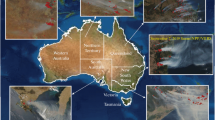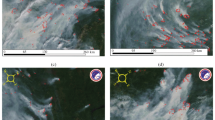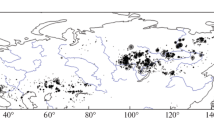Abstract
We describe the specific features of the summer 2010 emergency conditions in the European part of the Russian Federation, when an anomalous heat wave (the monthly mean temperatures in the summer months were 5–9°C higher than those for 2002–2009) and prolonged blocking anticyclones led to large wildfires. We analyze their causes and consequences. The features of the satellite system for operational fire monitoring (constructed at the Aerospace Scientific Center) and examples of its application in summer 2010 are presented. On the basis of the results of processing of satellite images of low (250–1000 m), medium (∼30–50 m), and high (∼6 m) resolutions, we found that the total area covered by fire from March to November of 2010 amounted to approximately 10.9 million hectares for the entire territory of the country and and 2.2 million hectares for its European part. Daily histograms of areas covered by fire in the summer months of 2010 were constructed. On the basis of these data and empirical models, we estimate the daily emissions of carbon monoxide (CO) from wildfires in the summer months of 2010 for the European part of Russia and Moscow oblast. On some days in August 2010, these emissions reached 15000–27000 t for the European part of Russia and 3000–7500 t for Moscow oblast. On the basis of analysis of data from the AIRS spectrometer (Aqua satellite), we derived the spatial distribution of CO concentrations at heights of 2 to 10 km above the territory of the Eastern and Central Europe. Moscow was shown to have been most severely affected by smoke from wildfires occurring on August 6–9, 2010, when the concentrations of harmful gases (CO2, CO, CH4, and O3) and aerosols in the air significantly exceeded both the daily and the one-hour maximum allowable concentrations.
Similar content being viewed by others
References
Bondur, V.G., Principles of Construction of the Space System for Monitoring the Earth for Environmental and Natural-Resource Purposes, Izv. Vuzov, Ser. Geodez. Aerofotos., 1995, no. 2, pp. 14–38.
Bondur, V.G., Krapivin, V.F., and Savinykh, V.P., Monitoring i prognozirovanie prirodnykh katastrof (Monitoring and Forecasting of Natural Disasters), Moscow: Nauchnyi mir, 2009.
Bondur, V.G., Topicality and Necessity of Space Monitoring of Natural Fires in Russia, Vestn. ONZ RAN, 2010, vol. 2, no. Z11001.
Hansen, M., DeFries, R., Townshead, J.R.G., et al., Global Land Cover Classification at 1 km Resolution using a Classification Tree Approach, Int. J. Remote Sens., 2000, vol. 21, nos. 6–7, pp. 1331–1364.
Hoelzemann, J.J., Schultz, M.G., Brasseur, G.P., et al., Global Wildland Fire Emission Model (GWEM): Evaluating the Use of Global Area Burnt Satellite Data, J. Geophys. Res., 2004, vol. 109, no. D14SO4. doi: 10.1029/2003JD003666.
Isaev, A.S. Korovin, G.N., et al., Ekologicheskie problemy pogloshcheniya uglekislogo gaza posredstvom lesovosstanovleniya i lesorazvedeniya v Rossii: Analiticheskii obzor (Environmental Problems of Absorbing Carbon Dioxide through Reforestation and Afforestation in Russia: An Analytical Review), Moscow: Tsentr Ekologicheskoi Politiki Rossii, 1995.
Roy, D.P., Boschetti, L., Justice, C.O., et al., The Collection 5 MODIS Burned Area Product—Global Evaluation by Comparison with the MODIS Active Fire Product, Rem. Sens. Environ., 2008, vol. 112, no. 9, pp. 3690–3707.
Savin, A.I. and Bondur, V.G., Scientific Basis for the Creation and Diversification of the Global Aerospace Systems, Opt. Atmos. Okeana, 2000, vol. 13, no. 1, pp. 46–62.
Seiler, W. and Crutzen, P.J., Estimates of Gross and Net Fluxes of Carbon between the Biosphere and Atmosphere from Biomass Burning, Clim. Change, 1980, vol. 2, pp. 207–247.
Shchetinskii, V.E., Kotel’nikov, R.V., Sementin, V.L., Lupyan, E.A., Flitman, E.V., Shcherbenko, E.V., Galleev, A.A., Efremov, V.Yu., Tolpin, V.A., Mazarov, A.A., Krasheninnikova, Yu.S., and Ershov, D.V., Primenenie informatsionnoi sistemy distantsionnogo monitoringa “ISDM Rosleskhoz” dlya opredeleniya pozharnoi opasnosti v lesakh Rossiiskoi Federatsii (Application of the ISDM Rosleskhoz Information System for Remote Monitoring to Determine the Fire Danger in Forests of the Russian Federation), Pushkino, Moscow oblast: FGU Avialesookhrana, 2008.
Vivchar, A.V., Moiseenko, K.B., and Pankratova, N.V., Estimates of Carbon Monoxide Emissions from Wildfires in Northern Eurasia for Air Quality Assessment and Climate Modeling, Izv. Atmos. Ocean. Phys., 2010, vol. 46, no. 3, pp. 281–293.
Vorob’ev, Yu.L., Akimov, V.A., and Sokolov, Yu.N., Lesnye pozhary na territorii Rossii: sostoyanie i problemy (Forest Fires in Russia: State and Problems), Moscow: DEKSPRESS, 2004.
Wiedinmyer, C., Quayle, B., Geron, C., et al., Estimating Emissions from Fires in North America for Air Quality Modeling, Atmos. Environ., 2006, vol. 40, no. 19, pp. 3419–3432.
Author information
Authors and Affiliations
Corresponding author
Additional information
Original Russian Text © V.G. Bondur, 2011, published in Issledovanie Zemli iz Kosmosa, 2011, No. 3, pp. 3–13.
Electronic supplementary material
Rights and permissions
About this article
Cite this article
Bondur, V.G. Satellite monitoring of wildfires during the anomalous heat wave of 2010 in Russia. Izv. Atmos. Ocean. Phys. 47, 1039–1048 (2011). https://doi.org/10.1134/S0001433811090040
Received:
Published:
Issue Date:
DOI: https://doi.org/10.1134/S0001433811090040




